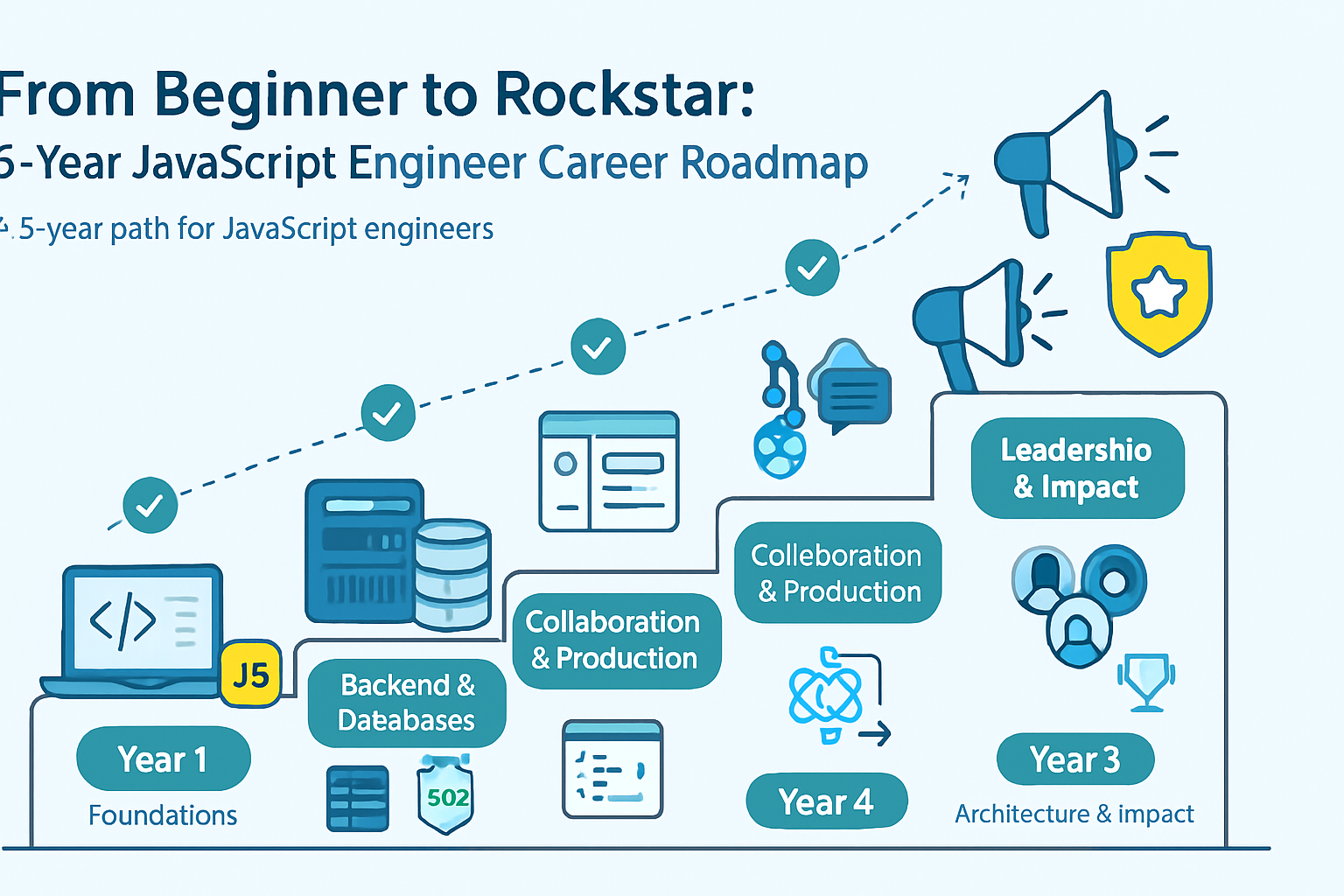· career · 7 min read
From FAANG to Founders: Leveraging Your Experience to Build a Startup
A practical guide for JavaScript engineers who want to leave FAANG and start a company - how to spot high-leverage opportunities, use your inside knowledge and network, build an MVP with JavaScript, and raise early capital.

Why FAANG experience is a real asset - and how to use it
Working at a FAANG company gives you more than a line on your resume. It provides:
- Deep exposure to large-scale systems and product/engineering processes.
- Data-driven thinking, instrumentation, and metrics fluency.
- Access to talented peers and a broad professional network.
- Credibility with investors and early hires.
But those strengths only matter if you translate them into startup-specific skills: rapid iteration, customer obsession, and ruthlessly prioritizing what matters for product-market fit.
The trap: assuming what works at scale will work for a tiny, evolving product. You must unlearn some big-company habits (long planning cycles, cargo-culting metrics, heavy process) and keep the technical rigor and product sense that matter.
Step 1 - Identify market gaps that you can uniquely see
Your best startup ideas usually come from problems you lived through at FAANG or in adjacent ecosystems. Approaches to find those high-leverage gaps:
- Revisit friction you encountered: internal tools, slow workflows, missing integrations, reporting gaps.
- Talk to ex-colleagues in other teams - compare pain points across orgs and companies.
- Scan vendor lists and procurement patterns: what tools keep being bought but still feel broken?
- Monitor engineering and product communities (Twitter, Hacker News, subreddits) for recurring complaints.
- Use your data instincts: look for leaky funnels, manual workarounds, or high time/cost per transaction.
Tactics for validation:
- Do 30–50 customer interviews focused on behavior, not opinions. Ask to walk you through their last time they did X.
- Build a landing page + optimizer ads or an email waitlist to measure interest before building.
- Ship a manual (concierge) version of the product to learn fast - see Paul Graham’s classic essay “Do Things That Don’t Scale” for why this works.
Step 2 - Convert FAANG cred into momentum (without ego)
Your background opens doors, but investors and early customers care about signals like traction and focus. Ways to convert your background into real momentum:
- Use introductions sparingly and for high-leverage asks (pilot customers, referrals, first hires).
- Frame your FAANG experience as domain expertise: show metrics, use cases, and specific outcomes you observed.
- Offer to do a pilot or PoC for your ex-employer or former colleagues - internal credibility is a powerful early customer channel.
- Publish a short case study or technical blog post demonstrating the problem and your early solution.
Networking playbook:
- Make a 30-minute outreach template that references shared context (team, project, or tool).
- Offer tangible value in early conversations (help debug a problem, provide a short audit, or propose a pilot timeline).
- Keep investors and mentors updated with concise, metric-driven progress emails (weekly or biweekly templatized update).
Step 3 - Build your JavaScript-first MVP smartly
As a JavaScript engineer you can iterate quickly. But speed without direction wastes time. Priorities for the tech stack and architecture:
- Start with lightweight frameworks you know (React or Preact for front-end; Next.js for server rendering; Node.js or Deno for backend APIs).
- Use managed services to avoid ops (Vercel/Netlify, Firebase/Clerk/Auth0, Stripe, AWS managed DBs, Supabase) - serverless-first is often the right call for early startups.
- Instrument everything from day one: product events, conversion funnels, error tracking (Sentry), and user session analytics (PostHog or Mixpanel).
- Favor modular, replaceable components. You will re-architect once you find product-market fit.
MVP checklist (technical):
- Clear MVP success criteria (activation, retention, paying conversion).
- Logging and observability (errors, latency, business metrics).
- Fast feedback loop for shipping (CI/CD pipeline, feature flags).
- Basic security and compliance where needed (OWASP basics, GDPR/CCPA awareness).
Step 4 - Go-to-market: selling what engineers often underestimate
Engineers tend to underinvest in GTM. Launching successfully requires a plan for acquiring and converting customers:
- Start with a small, well-defined niche (a specific role, team, or vertical).
- Use your network for initial pilots; treat early customers as product partners.
- Price experiments early - even a small price reveals real value alignment.
- Content + engineering synergy: technical blog posts, reproducible demos, and open-source tooling attract a developer audience.
Channels that work for ex-FAANG founders:
- Developer evangelism (open-source libraries, examples, talks).
- Enterprise pilots through existing contacts.
- Paid ads targeted to job titles or tools (if you have a conversion-ready landing page).
- Partnerships with complementary tooling vendors.
Step 5 - Fundraising: tell a story investors can believe
Your FAANG history helps with introductions, but investors fund trajectories, not pedigrees. The story should include:
- Clear problem and why the team is uniquely suited to solve it.
- Early evidence of demand (interviews, pilots, usage metrics, revenue).
- A simple projection of how you scale go-to-market and unit economics.
- A short, realistic use of funds and milestones for the next 12–18 months.
Practical tips:
- Seed rounds often want 12–18 months of runway to reach an inflection (e.g., $500k–$2M depending on burn).
- Keep cap table simplicity and founder control in mind. Use standard docs (Simple Agreement for Future Equity - SAFEs - or standard seed-priced rounds).
- Prepare a one-page summary and a 10–12 slide deck focused on problem, evidence, solution, market, traction, team, and ask.
Resources: Y Combinator’s startup library is a great practical compendium: https://www.ycombinator.com/library
Step 6 - Building the first team (cofounder, first hires)
Your cofounder choice is one of the highest-leverage decisions:
- Complementary skill sets beat clones. If you’re a technical founder, prioritize a cofounder who’s strong at sales/ops or product/marketing.
- Look for senior ICs who want to make an outsized impact; former FAANG teammates can be great cultural fits but may prefer stability.
- Hire for mission alignment and early-stage adaptability.
Interview process for early hires:
- Keep it short: work sample, a practical take-home or pair-program session, and a culture/vision interview.
- Trust signals matter: open-source contributions, operational ownership at past teams, and experience owning outcomes.
Compensation mix:
- Be transparent about equity vs salary tradeoffs.
- Use option pools and standard vesting (4 years with 1-year cliff is common).
Legal, IP, and the things founders often forget
- Check your FAANG employment agreement for IP and non-compete/non-solicit clauses. Get a lawyer if you’re unsure.
- Don’t recruit a bunch of ex-colleagues at once - this can trigger legal issues with your old employer.
- Incorporate early (C-Corp in the U.S. is common for raising VC), and set up basic governance.
Risk management and financial planning
- Plan runway conservatively. Factor in hiring, dev costs, and unexpected delays.
- Consider a phased exit strategy: side-project monetization, consulting, or selling to a strategic buyer if product-market fit is slow.
- Keep emergency funds - leaving FAANG reduces cash runway but can be mitigated by phased transitions (part-time, sabbatical, or contractor work).
Common pitfalls (and how to avoid them)
- Building a product without validated customers: fix with early customer interviews and pilots.
- Overengineering the stack before product-market fit: favor simple, replaceable choices.
- Hiring too quickly: hire for outcomes not titles.
- Relying solely on FAANG credibility: convert introductions into pilots and measurable results.
A pragmatic 90-day plan for the transition
Week 1–4: Idea validation
- 30 customer discovery interviews.
- Landing page + email capture.
- Manual concierge or prototype to test core hypothesis.
Week 5–8: Early product + pilot
- Build a minimal MVP that proves activation or retention.
- Run a pilot with 1–3 early customers from your network.
- Set up analytics, simple billing, and customer feedback loops.
Week 9–12: Prep to scale or fundraise
- Refine pricing and onboarding based on pilot data.
- Prepare a short investor deck and a 1-page plan.
- Decide on the company formation and basic legal docs.
Resources and further reading
- Paul Graham - Do Things That Don’t Scale: http://paulgraham.com/ds.html
- The Lean Startup (Eric Ries): https://theleanstartup.com/
- Y Combinator Startup Library: https://www.ycombinator.com/library
- Lean Canvas: https://leanstack.com/
Final notes
Leaving a FAANG company to found a startup is both higher risk and higher optionality. Your technical expertise, product sensibility, and network give you a privileged starting point - but the decisive factors are problem selection, speed of learning, and the ability to turn credibility into measurable momentum.
If you treat the move as a product: form a hypothesis, run rapid experiments, and iterate toward the market that values what you build, you dramatically increase your odds of success.
Good luck - build small, learn fast, and ship what people actually need.



